8 Shed Foundation Types Reviewed And How To Choose The Right Base For Your Shed
There isn't such a thing as a 'one size fits all' shed foundation. There is such a variation in size of shed, usage of sheds and also variation in the ground itself that you will need to make some sort of judgement based on your situation.
I have put together a guide to 8 shed foundation options on this page. To find out more about how to build each type of foundation for a shed, just click on the links for more in-depth instructions.
I have written articles on each of the commonly used foundation types with a brief introduction to each one below. It is great to have a repertoire of options to choose the best solution for any given situation:
- Poured concrete base
- Adjustable metal base
- Adjustable plastic base
- Pier foundation
- Retaining wall type base
- Plastic grid shed base
- Concrete paving slabs
- Crushed stone shed base
- Ground Screw Shed base
So what is the best foundation for a shed?
1.0 Concrete shed baseUsing a poured concrete slab for a shed base is perhaps the most robust and durable type of shed foundation. Often known as a 'raft' this type of foundation can include reinforcement or just be plain concrete.
More on how to build a concrete shed base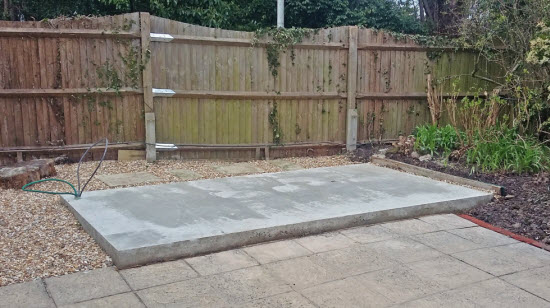 Completed concrete shed base before commencing shed construction
Completed concrete shed base before commencing shed construction
Adjustable shed bases
A lighter and more flexible option is to create an adjustable shed base. This option allows you to easily creating a level platform on which to build your shed. There are two categories of shed leveling kit depending on the size and loading of your shed.
2.0 Adjustable base with steel jacksThe size of shed jack that works for most sheds is the Quickjack shed base. This shed leveling kit uses a metal levelling jack and a timber framework to create an adjustable shed base system to support small buildings.
I used the Quikjack shed base supports to create the foundation for a prefabricated log cabin and found that it worked very well.
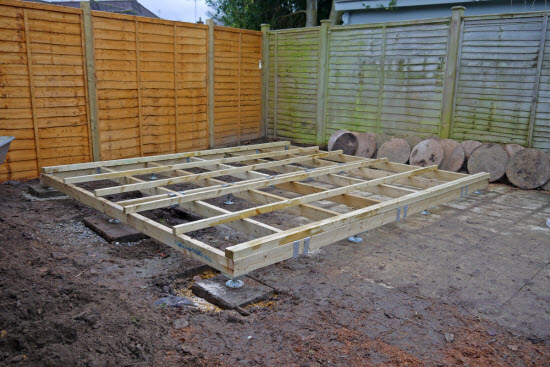 Adjustable shed foundation - metal jacks
Adjustable shed foundation - metal jacks
3.0 Adjustable base with plastic shed jacks
When it comes to the smallest sheds foundations are often not needed the existing landscaping may have more than sufficient capacity to support the shed. The adjustable shed feet enable the shed to be built on the sloping brick pavers.
Smaller sheds using adjustable plastic shed jacks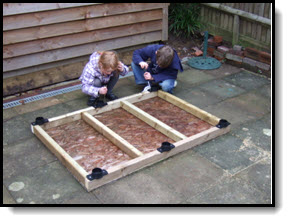 Adjustable shed foundation - using plastic jacks
Adjustable shed foundation - using plastic jacks
How to build a shed on a slope
There is no doubt that building a shed on uneven ground is a bit more challenging than a perfectly flat site. But building a shed foundation on a slope is easily manageable.
This article shows you the two main options: Two ways of building a shed on a slope
 Which option is best for you?
Which option is best for you?
The most common option for building a shed on a slope is the pier foundation. It is also useful on flat ground.
Shed pier foundation.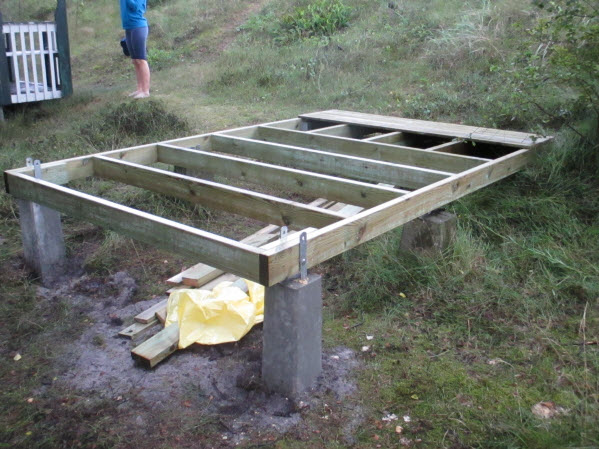 Shed pier foundation
Shed pier foundation
Cheapest/easiest shed foundations
Cost and ease of installation are often important for shed builders. These three foundation types are all relatively easy to install with minimal excavation.
One of the most important factors for all shed foundations is that the base is level. This makes construction of the shed to the required accuracy much easier.
The foundations are listed below in order of ease of construction, mainly because of the weight of materials:
Plastic shed foundation - Using a plastic base for a shed is a quick and easy shed foundation option. Their lightweight removes some of the heavy work involved in building a shed base.
The plastic foundation grids are durable and reusable too. Although I am not a great fan of plastic the fact that they can be reused helps.
Find out more about how to lay a plastic shed base
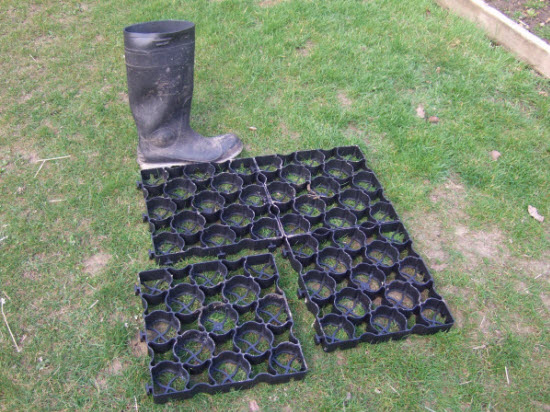 Interlocking plastic foundation grids
Interlocking plastic foundation grids
Building a shed base with paving slabs - Building a concrete paver shed foundation is a cheap and durable method of creating a shed base. They act to spread the load over the full footprint of the shed.
It is quite heavy work to do it this way but you can be sure that it will last for many years. Find out more about how to build a shed base with paving slabs
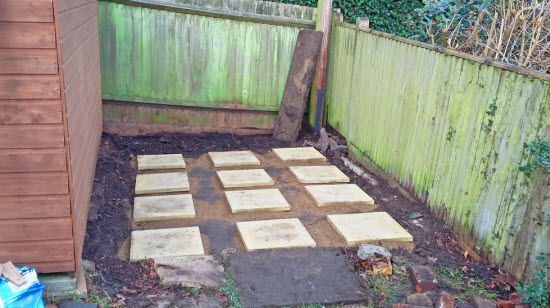 Shed foundation using concrete paving slabs
Shed foundation using concrete paving slabs
8.0 Timber and crushed stone shed base
Timber bearers - Timber bearers are a good foundation method. As the foundation is made of long straight elements it can be easier than other types to construct a good level support.
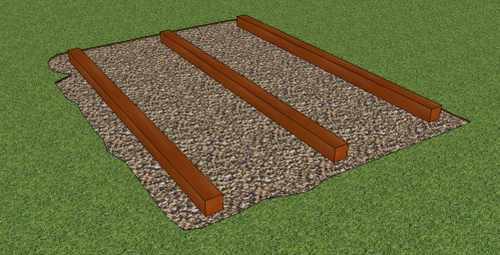 Building a shed foundation with timber bearers
Building a shed foundation with timber bearers
Ground Screws - Ground screws are an increasingly popular type of shed base. They are quick to install, require minimal digging and there is no construction spoil. What's not to like?
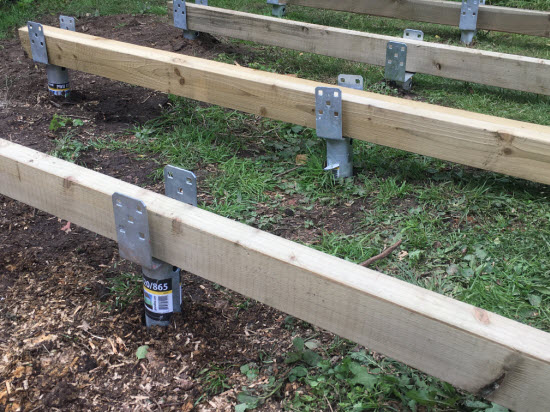 Close up of ground screw with timber bearers
Close up of ground screw with timber bearers
Shed foundation summary
This article has summarised the the main types of shed foudnation and then links to more in depth articles which show you how to build each type.
The main types of shed foundation are:
- Adjustable plastic base
- Adjustable metal base
- Plastic
- Timber
- Concrete paving slabs
- Poured concrete base
- Pier foundation
- Retaining wall type base
Now you know about the different types of shed foundation let's go a bit deeper into the design of shed foundations. How do shed foundations work? What can you expect from a shed foundation? How deep should a shed foundation be? What if you choose the wrong type of foundation?
How do shed foundations work?
All foundations work in a similar way by distributing the weight of a shed over a larger area so that they do not exceed the bearing capacity of the ground that supports them.
To explain this in simple terms, imagine you are walking in the snow in your normal boots, with each footstep you sink up to your knees (or further) depending on how deep the snow is. However, if you wear snow shoes your weight is distributed over a larger area and you can walk more easily without sinking in so deep.
Shed foundations work in a similar way by spreading the weight of the shed over a large area so that the timbers don't sink into the soil.
What can you expect from a shed foundation?
Shed foundations aren't as stable as a house foundation. They generally don't need to be as stable as it doesn't matter so much if the shed moves a little bit.
House foundations are dug deep and designed to keep movements to a minimum. This is for several reasons including:
- Drainage connections to the house would be affected by movement
- Cracks in a house wall are a lot more noticeable and concerning
- Houses often have brittle internal finishes so cracks are more noticeable
- Houses are larger than sheds and so if one part moves a different amount to another then some form of crack will occur
If a shed does move and tilt to one side for some reason. It is quite easy to straighten them up and make them level again, because they are small and relatively light .
How deep should shed foundations be?
As we discussed above, house foundations are designed for minimal movement and so are dug relatively deep. Dependent on where you live and the type of soil underlying your house a typical absolute minimum depth of house foundation is about 400mm.
The reason for this is so that the underside of the foundation is beneath the 'frost zone'. As the ground gets cold and freezes in the winter the soil expands and can lift structures where the underside of the foundation is above this zone.
The frost zone varies dependent on how far North you live the colder the area the deeper the frost zone. For most places in the UK the minimum foundation depth for houses is 600mm.
However, for foundations for sheds don't need to be anywhere near this depth. Because it doesn't matter so much if sheds move (see above) shed foundations can be relatively shallow. Even if you live in frost susceptible zones.
Generally the ground in an area has better bearing capacity the deeper you dig and will also be more stable.
For ongoing tips and advice to progress your shed building project add your name to my email list using the box below.
Your email address will be kept confidential and won't be shared.
Easily unsubscribe at any time. I hate Spam as much as you do!

Keep in touch with our monthly newsletter
Shed Building Monthly



